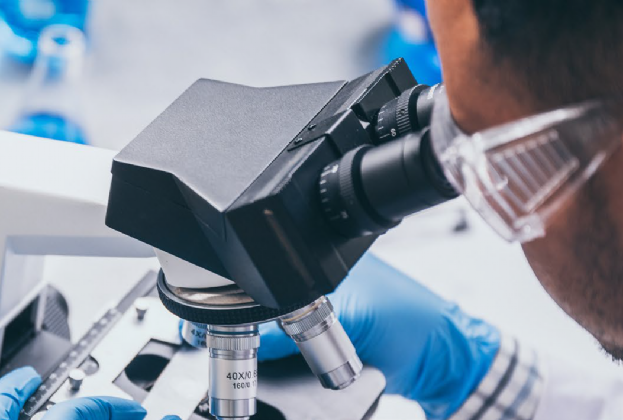Coworking has seen an exponential rise in popularity in the past decade. WeWork, for example, founded in 2010, has already expanded from the U.S. into 14 other countries, and recently garnered a $17 billion valuation. Some of the reasons for coworking’s popularity have indelible appeal: multiple parties can share the cost of rent, companies can easily scale their space up or down in response to changing needs, and all members can enjoy the ease of a serviced office.
Businesses in any industry can reap those benefits, but for the scientific community in particular, coworking can bring additional perks. This HOK piece on the future of scientific workplaces identifies some of the major changes in pharmaceutical work that are driving the need for new, more flexible types of research spaces: an expectation for more speed and agility; technological advancement leading to smaller tools; and the entry of Generations Y and Z into the workforce—a cohort that’s demonstrated it values performance over ownership. At the same time, intellectual property concerns around sharing workspaces and equipment are beginning to give way to the benefits of collaboration and innovation possibilities that lie in companies’ cross-pollination.
Alongside these drivers, cultural elements are also working to spur coworking’s appeal. As tech companies have moved from suburban locations into cities, their company cultures and workplaces become “socialized” in much the same way cities themselves have grown up—and much to corporate benefit. When space is tighter, people interact more; that increased communication leads to increases in productivity, collaboration, and innovative problem solving.
“After deploying thousands of badges in workplaces ranging from pharmaceuticals, finance, and software companies to hospitals, we’ve begun to unlock the secrets of good office design in terms of density, proximity of people, and social nature,” write Ben Waber, Jennifer Magnolfi, and Greg Lindsay in the Harvard Business Review article “Workspaces That Move People.” “We’ve learned, for example, that face-to-face interactions are by far the most important activity in an office.”
Science departments at top research schools like MIT and Carnegie Mellon have mimicked this effect by opening their undergraduate labs to master’s and doctoral students to encourage the flow of knowledge between research focuses and age groups.
As physical technology gets smaller and opens up more vacant space in labs; as many scientists, researchers, and engineers can now do the bulk of their work from anywhere with the right data connection; and as science-based companies begin to see how working in closer proximity with peer organizations can benefit them, traditional research environments begin to look ripe for transformation into science-focused coworking spaces.
Still, rates of traditional coworking in biotech industries continue to lag behind those in the software, design, marketing, and other fields—though this may finally be changing. Kerranna Williamson, founder of medical diagnostics company ALIS Heath, says, “In some ways, this industry has been more reticent to jump into coworking, perhaps due to fear of being able to protect new discoveries. In the last five to ten years, though, I have seen the perspective shift. I have also noticed a remarkable uptick in open workspace and coworking layouts in the corporate environment… More and more individuals working for biotech and health-related companies are working out of coworking spaces across the globe.”
In science fields, coworking has thus far mostly taken the shape of an accelerator or incubator. For example, Grants4Apps, Bayer's accelerator program, offers qualified digital health startups a combination of funding, coworking space, and mentorship at Bayer campuses in Berlin and Toronto. This strategy employs coworking as part of the company’s R&D initiative. Bayer also operates the incubator CoLaborator, and its Guatemala City office was redesigned with a coworking-inspired layout.
BioLabs follows a different model, selling monthly memberships to startups who want to work in a collaborative environment with access to (expensive) lab equipment and other organizations in the life sciences space. These specialized environments fulfill the unique spatial and technological needs of life sciences organizations, which cannot always be met by traditional coworking operators like WeWork. BioLabs currently has locations in New York, Cambridge, Durham, and San Diego, and 230 member organizations.
Then there is Brooklyn’s Genspace, “the world’s first community lab,” which describes itself as “a place where anyone can learn and work on biotechnology.” Genspace reframes the biotech lab as a nonprofit community with a “hacker and maker” feel, and invites everyone from journalists and students to scientists and artists to tinker with 3D modeling, “DNA hacking,” and reverse-engineering lab equipment in an effort to “remember what ignited their inner scientist originally.”
While the above examples are current, and mostly large-scale, the use of coworking spaces by the pharma and life sciences industries has yet to go truly mainstream. According to Deskmag’s 2016 coworking forecast, only about four percent of professionals using coworking spaces self-identify as working in a research capacity—though this is double the two percent reported in 2014. Williamson predicts the life sciences industry will continue to move into coworking spaces for a number of reasons, including “more involvement from economic centers and local governments in backing biotech-specific shared space, and more consolidation in branding, networks, and sharing of resources.”
All signs point to the fact that that it is only a matter of time until the pharma and life science industries are leveraging the myriad benefits of coworking to their full advantage.
(1).jpg)
.jpg)
.jpg)
.jpg)
.jpg)



.jpg)